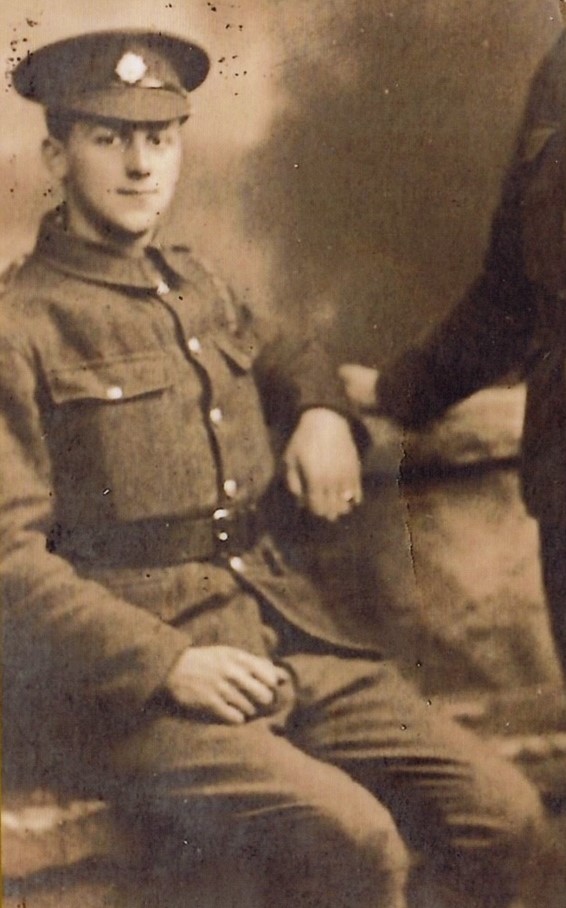Rfn
Thomas Frank Hardwicke
Information about birth
|
Year of birth: 1894 |
|
Place of birth: Worcester, Worcestershire, England, United Kingdom |
General information
|
Last known residence: Farnham, Surrey, England, United Kingdom |
|
Profession: Domestic worker |
Army information
|
Country: England, United Kingdom |
|
Force: British Expeditionary Force |
|
Rank: Rifleman |
|
Service number: B/201426 |
|
Enlistment place: London (City), Middlesex, England, United Kingdom |
|
Units: — London Regiment, 1/28th Bn. (Artists' Rifles) (Attached) |
Information about death
|
Date of death: 30/10/1917 |
|
Place of death: Source Trench, Passchendaele, Belgium |
|
Cause of death: Killed in action (K.I.A.) |
|
Age: 23 |
Memorial
|
Tyne Cot Memorial Panel: 146 A |
Distinctions and medals 3
|
1914-15 Star Medal |
|
British War Medal Medal |
|
Victory Medal Medal |
Points of interest 4
| #1 | Place of birth | ||
| #2 | Last known residence | ||
| #3 | Enlistment place | ||
| #4 | Place of death (approximate) |
My story
Thomas Frank Hardwicke was born in 1894 in Worcester, England. He was the son of Henry William and Annie Hardwicke (born Loveland). His father worked as a coachman and stable boy and before that had served 12 years in the Commissariat and Transport Corps until 25 March 1893, where he attained the rank of corporal. In 1900, aged 37, he re-enlisted in the Army Service Corps. He died in 1907. Frank's mother Annie remarried Harry Potter in Farnham, Surrey, in 1909. A few years later, in the 1911 census, Frank was living at Theobolds, Chilworth, Surrey. He was listed as the domestic servant of John Arthur Bleackley. Following in his father's footsteps, Frank enlisted in the Army Service Corps. He disembarked in France on 31 May 1915. During the war, he was transferred to the Rifle Brigade and eventually assigned to the London Regiment, 1/28th Battalion (Artists' Rifles), 190th Brigade, 63rd (Royal Navy) Division.
In late October 1917, while the Canadian Corps was storming the heights near Passchendaele, the 63rd (Royal Naval) Division was operating on the Canadian left flank. On 28 October, the Artists' Rifles moved into the line, relieving the Nelson Battalion. Its headquarters was at Albatross Farm. At 5.50am on 30 October, the 190th Brigade attacked between Poelcapelle and Passchendaele with the Artists' Rifles, the 4th Bedfordshires and the 7th Royal Fusiliers. Immediately the Artists' Rifles came under heavy machine-gun fire and as they struggled in the mud to keep up with the barrage, the German artillery dropped a counter-barrage, behind the British barrage, trapping the Artists' Rifles in the open. The Artists' Rifles suffered heavy losses and entrenched themselves at Source Trench, east of Varlet Farm. Further advance was almost impossible. The line occupied by the 63rd Division at nightfall ran from right to left: Source Trench - Varlet Farm - Bray Farm - Berks Houses. On the evening of the 31st, the battered battalion was relieved at Source Trench by the Nelson Battalion. It had suffered heavy losses. Six officers were killed, four wounded and a total of 70 men were killed, 130 wounded and 124 missing.
Frank, aged only 23, fell on 30 October 1917. He has no known grave to date and is commemorated on the Tyne Cot Memorial, panel 146 A.
In late October 1917, while the Canadian Corps was storming the heights near Passchendaele, the 63rd (Royal Naval) Division was operating on the Canadian left flank. On 28 October, the Artists' Rifles moved into the line, relieving the Nelson Battalion. Its headquarters was at Albatross Farm. At 5.50am on 30 October, the 190th Brigade attacked between Poelcapelle and Passchendaele with the Artists' Rifles, the 4th Bedfordshires and the 7th Royal Fusiliers. Immediately the Artists' Rifles came under heavy machine-gun fire and as they struggled in the mud to keep up with the barrage, the German artillery dropped a counter-barrage, behind the British barrage, trapping the Artists' Rifles in the open. The Artists' Rifles suffered heavy losses and entrenched themselves at Source Trench, east of Varlet Farm. Further advance was almost impossible. The line occupied by the 63rd Division at nightfall ran from right to left: Source Trench - Varlet Farm - Bray Farm - Berks Houses. On the evening of the 31st, the battered battalion was relieved at Source Trench by the Nelson Battalion. It had suffered heavy losses. Six officers were killed, four wounded and a total of 70 men were killed, 130 wounded and 124 missing.
Frank, aged only 23, fell on 30 October 1917. He has no known grave to date and is commemorated on the Tyne Cot Memorial, panel 146 A.
Sources 7
|
"Wonersh Fallen WW1" (Wonersh History Society, Wonersh) http://www.wonershhistory.co.uk/ Sources used |
|
1/28 Battalion London Regiment (Artists Rifles) (The National Archives, Kew (TNA), WO 95/3119/2). https://www.nationalarchives.gov.uk/ Sources used |
|
British Army World War I Medal Rolls Index Cards, 1914-1920 (The National Archives, Kew (TNA), WO 372). https://www.nationalarchives.gov.uk/ Sources used |
|
Census Returns of England and Wales, 1901 (The National Archives, Kew (TNA), RG13). https://www.nationalarchives.gov.uk/ Sources used |
|
Census Returns of England and Wales, 1911 (The National Archives, Kew (TNA), RG14). https://www.nationalarchives.gov.uk/ Sources used |
|
McCarthy Chris., Passchendaele. The Day-by-Day Account (London, Unicorn Publishing Group, 2018), 133. Sources used |
|
War Office: Soldiers’ Documents, First World War (The National Archives, Kew (TNA), WO 363). https://www.nationalarchives.gov.uk/ Sources used |
More information 3
|
Lives of the First World War (Imperial War Museum) https://livesofthefirstworldwar.iwm.org.uk/lifestory/1553042 |
|
Commonwealth War Graves Commission Database https://www.cwgc.org/find-records/find-war-dead/casualty-details/838455 |
|
Namenlijst (In Flanders Fields Museum) https://namenlijst.org/publicsearch/#/person/_id=54cdface-2698-4349-a078-6a0215a51b2a |
